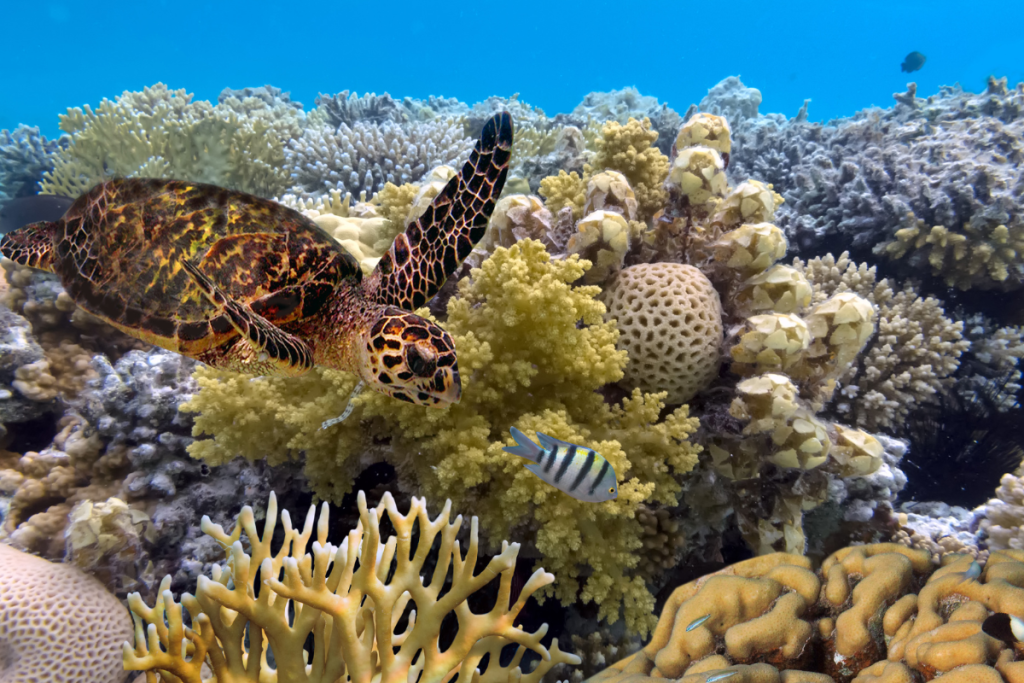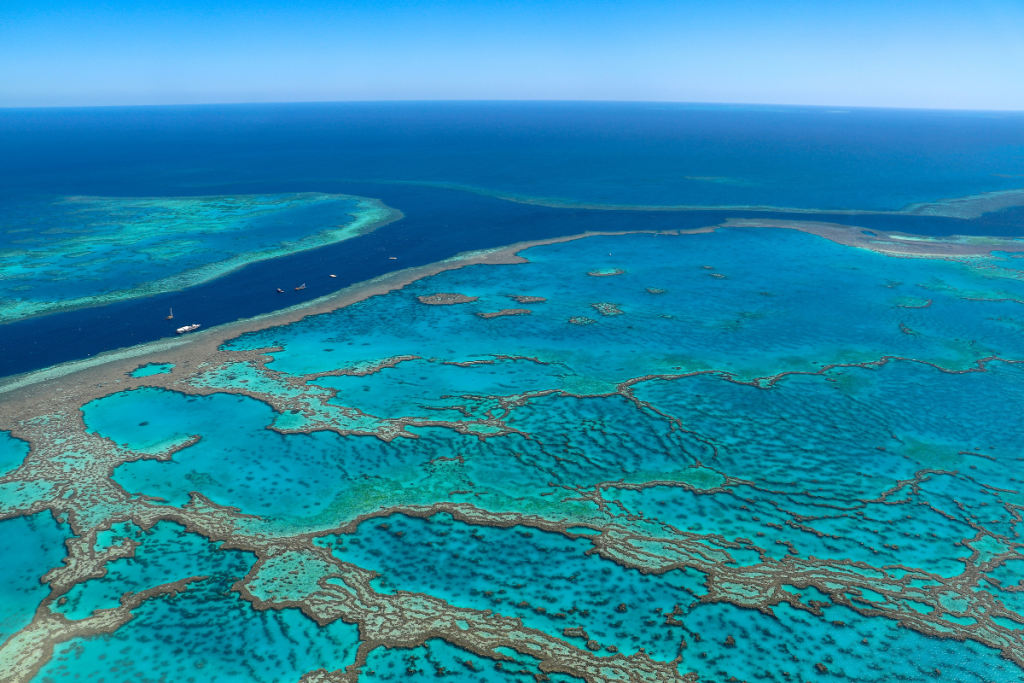The Great Barrier Reef is one of the world’s most spectacular natural wonders, offering unforgettable experiences year-round. Choosing the best time to visit depends on a variety of factors, including weather conditions, marine life sightings, and activities available. This guide provides all the essential details, from seasonal differences and temperature comparisons to unique experiences like snorkelling with turtles and witnessing coral spawning.
Dry Season (May-October)
The dry season is the most popular time to visit the Great Barrier Reef. With clear skies, lower humidity, and minimal rainfall, the dry season offers perfect conditions for outdoor activities, making it the best time for snorkelling, diving, and marine wildlife sightings.
- Weather: Average temperatures range from 18°C to 26°C, offering a mild, comfortable climate for outdoor adventures.
- Water Visibility: The dry season boasts some of the clearest waters, with visibility often reaching 20-30 meters, ideal for underwater exploration.
- Peak Tourism: June to October is peak season, meaning larger crowds and higher accommodation prices.
- Wildlife: The dry season is great for spotting humpback whales (June-September) and witnessing turtle nesting (October).
Pros
- Excellent weather for outdoor activities
- Crystal-clear waters for snorkeling and diving
- Great wildlife sightings, including whale watching and turtle nesting
- A wide variety of tours and activities available
Cons
- Higher prices for tours and accommodation
- Larger crowds at popular sites
Wet Season (November-April)
The wet season is less popular but offers unique experiences for those looking to avoid crowds. The weather is warmer, with frequent rain and occasional tropical storms, but the reef still provides excellent opportunities for exploration.
- Weather: Temperatures range from 24°C to 31°C, and humidity increases with occasional heavy rain.
- Water Conditions: Although visibility may be lower due to rainfall and runoff, the warm waters remain inviting for swimmers and snorkelers.
- Coral Spawning: A rare and spectacular event occurs in November, when coral releases eggs and sperm, creating a stunning underwater display.
Pros
- Fewer tourists and lower prices
- Unique experiences like coral spawning
- Warmer water for swimming
- Lush landscapes with vibrant rainforests
Cons
- Unpredictable weather with frequent rain
- Reduced water visibility for snorkelling and diving
- Marine stingers require protective suits
- Tropical storms can disrupt travel plans
Water Temperature and Visibility Comparison
Dry Season (May-October)
- Water Temperature: 22°C to 26°C – perfect for extended snorkelling and diving sessions.
- Visibility: 20-30 meters, providing clear views of coral gardens and marine life.
Wet Season (November-April)
- Water Temperature: 26°C to 30°C – warmer and more inviting for swimming.
- Visibility: Reduced visibility (10-15 meters) due to rainfall and runoff, but still great for snorkelling.
Weather and Temperature
Here’s a simplified summary of the weather across the year:
- June and July: Coolest temperatures and least rainfall
- November to April: Warmer temperatures, more rainfall, and higher humidity
- March and December: Hottest months with increased rain
Average Temperature and Rainfall:
- January: 31°C, 390mm rainfall
- February: 31°C, 360mm rainfall
- March: 30°C, 340mm rainfall
- April: 29°C, 200mm rainfall
- May: 27°C, 100mm rainfall
- June: 25°C, 50mm rainfall
- July: 25°C, 40mm rainfall
- August: 26°C, 30mm rainfall
- September: 27°C, 30mm rainfall
- October: 29°C, 50mm rainfall
- November: 30°C, 120mm rainfall
- December: 31°C, 200mm rainfall
Regional Weather Variations
The Great Barrier Reef spans a vast area, so weather conditions can vary from one region to another. These differences may influence your experience depending on where you’re staying and what activities you’re planning.
- Northern Reef (Cairns, Port Douglas): Warmer and more humid, with a higher chance of rain. Water temperatures are consistently warm, though visibility may suffer due to increased runoff.
- Central Reef (Whitsundays, Mackay): Generally experiences moderate conditions, with fewer storms and better conditions for outdoor activities.
- Southern Reef (Bundaberg, Gladstone): Milder climate with less humidity and rainfall. Water temperatures here tend to be cooler than in the north, and visibility is clearer year-round.
For a more detailed map of the Great Barrier Reef regions, consider using a map for better geographical understanding.
Activities and Attractions
Snorkeling and Diving
The Great Barrier Reef offers some of the world’s most spectacular snorkeling and diving opportunities. The dry season (May-October) is the best time to enjoy clear waters and vibrant marine life, but the wet season has its own unique offerings.
- Snorkelling with Sea Turtles: One of the most magical experiences on the reef is swimming with sea turtles. These graceful creatures can be seen year-round, especially around coral gardens and seagrass beds. The dry season provides optimal visibility for up-close encounters.
- Diving the Reef: Divers will find themselves surrounded by an incredible array of marine life, from colorful coral gardens to reef sharks and manta rays. The dry season offers clear waters with 20-30 meters of visibility, making it perfect for underwater photography.
- Coral Spawning in November: If you’re visiting during the wet season, don’t miss the rare coral spawning event. In November, the corals release eggs and sperm, creating a stunning underwater spectacle. This natural event attracts plankton feeders and is an extraordinary opportunity for divers.
Wildlife Tours
- Whale Watching: From June to September, humpback whales migrate along the reef, offering thrilling whale-watching opportunities.
- Turtle Nesting: From October to March, you can witness turtles nesting and the hatching of baby turtles, which occurs in January and February.
Island and Beach Exploration
- Best Time to Visit: Year-round, but the dry season provides the most pleasant conditions.
- Wet Season Impact: Higher humidity and rainfall may make it less enjoyable to spend long hours on the beach during the wet season.
Pros and Cons of Visiting During Each Season
Dry Season (May-October)
Pros
- Perfect weather for outdoor activities
- Clear water for snorkeling and diving
- Great wildlife sightings, including whale watching and turtle nesting
- A variety of tour options and experiences
Cons
- Higher prices and larger crowds
- Some sites can be crowded during peak times
Wet Season (November-April)
Pros
- Lower prices and fewer tourists
- Unique natural events like coral spawning
- Warmer waters for swimming
- Lush landscapes with vibrant rainforests
Cons
- Unpredictable weather with rain and humidity
- Reduced visibility for diving and snorkeling
- Presence of marine stingers
- Tropical storms may disrupt plans
Responsible Tourism
To protect the reef for future generations, it’s essential to follow responsible tourism practices. Here’s how you can enjoy the reef while minimising your environmental impact:
- Avoid Touching or Stepping on Coral: Coral reefs are fragile ecosystems, and touching or stepping on them can cause lasting damage.
- Do Not Feed the Fish: Feeding fish disrupts their natural foraging behaviors and can harm the reef’s delicate food chain.
- Refrain from Collecting Marine Life: Do not collect coral, shells, or any marine life, as it threatens the biodiversity of the reef.
- Use Reef-Safe Sunscreen: Regular sunscreen contains chemicals that harm marine life. Opt for reef-safe options to protect the underwater ecosystem.
- Follow Local Marine Guidelines: Respect all local guidelines and regulations to minimize ecological disruption.
Additionally, consider supporting eco-certified tour operators who prioritise sustainability and conservation efforts, contributing to the preservation of the reef.
This version emphasises detailed descriptions of snorkelling and diving, responsible tourism, and the role of naturalist guides, offering a rich, engaging experience for readers while promoting sustainable practices.
Guided and Self-Guided Tour Options
Exploring the Great Barrier Reef is an unforgettable experience, and there are a variety of tour options available to suit all types of adventurers. Whether you prefer a guided tour with expert insights or the freedom of a self-guided adventure, the reef offers a range of experiences to cater to your preferences and needs.
Guided Tours
Guided tours are perfect for visitors who want to maximise their experience and learn more about the reef’s marine life, history, and ecology. Many tours are led by knowledgeable naturalist guides, offering in-depth educational experiences.
- Snorkelling and Diving Tours: These tours take you to the best reef sites, with professional guides who ensure your safety while providing educational commentary on the coral and marine life. Many diving tours cater to all experience levels, from beginners to advanced divers.
- Whale Watching and Wildlife Tours: During the whale migration season (June-September), specializsed whale watching tours provide the opportunity to see humpback whales up close. These tours often include marine biologists and naturalists who enhance the experience with expert insights into whale behaviour.
- Island Tours: Guided boat or helicopter tours to reef islands offer breathtaking aerial views and the chance to experience pristine beaches, nature walks, and wildlife viewing. Some tours include guided nature walks on islands like Fitzroy Island or Green Island, where you can explore the rainforest and coastal ecosystems.
Guided tours are typically all-inclusive, providing transportation, equipment, and refreshments, making them a stress-free way to enjoy the reef. They’re ideal for first-time visitors or those who prefer a structured experience.
Self-Guided Tours
For those who prefer a more independent exploration, self-guided tours allow you the freedom to explore at your own pace. Many reef areas are easily accessible from the mainland, and there are various options for creating your own adventure.
- Self-Guided Snorkeling: Visitors can rent snorkelling equipment and venture to accessible reefs such as those off the coast of Cairns or Port Douglas. These areas are known for their abundant marine life, and many locations are equipped with pontoons or floating platforms for ease of access.
- Scenic Reef Walks: In certain areas, such as the Whitsunday Islands, you can explore the coastline by foot on self-guided walks. These provide access to some of the most beautiful reef beaches and give you the chance to spot marine life and birds.
- Self-Drive Reef Tours: For those with a rental car, there are several scenic drives along the coast that lead to great reef viewing points and access to beaches where you can snorkel or simply enjoy the views. This type of tour provides flexibility and can be customized to suit your schedule and interests.
Self-guided tours are great for those who enjoy exploring independently and prefer to set their own itinerary. They allow visitors to explore at their own pace, without the structure of a formal tour, and often come at a lower cost.



